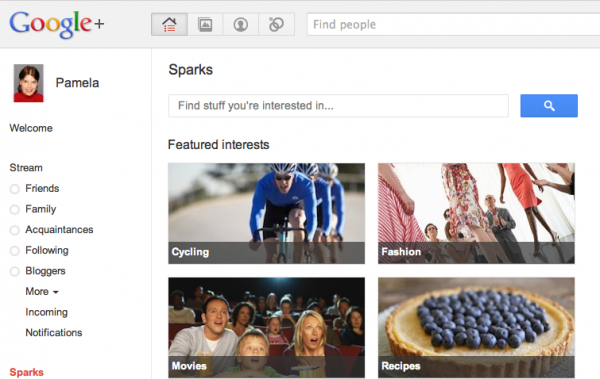Marketers Root For Expanded Opportunities Represented By Google+
Marketers have had a close eye on the launch of Google+, and what I’m hearing at this point is similar to what I once heard about Bing. In short, it’s great to have a potential competitor to the behemoth in the space (Facebook, in this case), but how important Google+ becomes to marketers will depend […]
 Marketers have had a close eye on the launch of Google+, and what I’m hearing at this point is similar to what I once heard about Bing. In short, it’s great to have a potential competitor to the behemoth in the space (Facebook, in this case), but how important Google+ becomes to marketers will depend on what kind of scale it achieves, and what kind of audience it ends up having.
Marketers have had a close eye on the launch of Google+, and what I’m hearing at this point is similar to what I once heard about Bing. In short, it’s great to have a potential competitor to the behemoth in the space (Facebook, in this case), but how important Google+ becomes to marketers will depend on what kind of scale it achieves, and what kind of audience it ends up having.
As Efficient Frontier’s senior director of business analytics Siddharth Shah notes in a blog post: “While features and tools might draw advertisers to a platform, it’s access to large audiences that is the biggest draw for advertisers when it comes to the adoption of a marketing platform.”
The most obvious Facebook analogue that was missing at Google+’s launch was the brand Page, which Google executives said would be coming soon, though they wouldn’t indicate when the new feature would launch. It’s apparently in the works, though, and head of commerce and local Jeff Huber said the company wanted small business profiles to be “great” and said “we’re coding as fast as we can.”
But as Ian Schafer, CEO of branding-oriented agency Deep Focus notes, there’s no obvious way for brand Pages to take part in Circles. Does a user have a special Circle for businesses, or does he include the Page for the local kayak shop in his “krazy kayakers” Circle?
AdWords+?
It’s pretty much a no-brainer that AdWords will show up at some point or another, but how exactly they will be targeted remains to be seen. The challenge is to make it as effective as possible for advertisers, without alienating consumers. One could imagine contextual targeting, based on the content of the page, as Gmail users have grown accustomed to seeing related ads beside e-mail messages. But Facebook-like targeting on demographics and interests doesn’t yet seem to be in the cards, as Google profiles don’t yet invite the same level of intimacy. Perhaps it’s because most of the folks in my Circles thus far are business contacts (the early adopter crowd), but I’m not as up for discussing my favorite TV shows on Google+ as I am on Facebook.
Craig Macdonald, Covario’s chief marketing officer and senior vice president for products, believes the eventual advertising opportunity on Google+ will resemble Facebook (demographic, interest-based and push) much more than search (keyword and pull). “Targeting should be do-able on any data provided by the user that is considered ‘public.’ In Facebook, this is data that is in a person’s public profile record — their home town, their residence, their hobbies, favorite book, etc. — as well as on the real time data stream from day-to-day comments, which should be target-able by ‘keyword.’ So a potential use case is: Let me serve a banner to everyone in California who uses the keywords ‘laptop’ or ‘personal computer’ or ‘HP’ or ‘Lenovo’ over a particular period of time. That seems like a completely reasonable use case – so long as the user understands the conditions.”
Differentiating Factors
Shah from Efficient Frontier suggests that Google has an opportunity to outdo Facebook by offering more transparent reporting about more complex targeting. “For instance, on the Facebook platform advertisers cannot target logical combinations of different interest segments (you can target people who are interested in bikes OR scooters OR cars but not those who like bikes AND scooters but NOT cars),” he said.
One interesting possibility for brand integration might also be the Sparks section, if it catches on. This area, seemingly meant for serendipitous discovery of items worth sharing, also allows users to bookmark, or pin, areas of interest so they can more easily find them again — enabling interest-based ad targeting. But it also serves as potential entry point for brands seeking to introduce wanna-be viral videos, or other content-based marketing efforts.
“Six Apart used to have an ad product like this, a thought-starter for bloggers, on their platform,” notes Deep Focus’ Schafer. “Google has that potential with Sparks.”
The caveat to any excitement about Google+’ possibilities as a marketing platform is the big question we started with: will it have a substantial enough user base to make it worth marketers’ while. Needless to say, the fact that so many are already logged-in to Google accounts for Gmail or Google Docs — as well as the potential for Android integration — are substantial advantages, but sharing, and keeping up with what your friends share, is an ongoing effort, and it remains to be seen whether people will make a place for it in their daily lives, as they have for Facebook. Marketers seeking new opportunities certainly hope so.
“I want them to be succesfun, because the more successful parties there are, the better we all are,” Schafer told me. “I’m sure there’s a lot more to come out of this.”
Related stories
